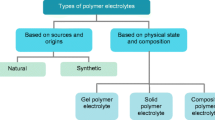Abstract
Poor conductivity and toxic technological garbage of polymer electrolyte has delayed energy storage application in electric vehicles. Biodegradable gel polymer electrolytes (GPEs) based on poly (ε-caprolactone) (PCL) are prepared. PCL is used to immobilize liquid electrolyte containing lithium bis(trifluoromethanesulfonyl) imide, ethylene carbonate, and propylene carbonate. Impedance spectroscopy, X-ray diffraction, and differential scanning calorimetry are used to characterize the ionic conductivity and structural and thermal properties of GPEs, respectively. For jelly-like GPEs, it exhibits liquid-like ionic conductivity of 1.69 × 10−3 S cm−1 at room temperature with a composition ratio (PCL:LiTFSI:EC:PC) of (22.5:7.5:35:35) (w/w). Results show that the polymer matrix forms cross-linked network within the liquid electrolyte, acting like an adhesive to hold the high fluidity liquid molecules. In temperature dependence studies, the GPEs are observed to obey Arrhenius equation indicating that ion transport occurs via hop** mechanism. The findings in XRD and DSC are in good agreement with conductivity results.







Similar content being viewed by others
References
Retrieve from http://www.paulchefurka.ca/WEAP/WEAP.html. Accessed 18 Jan 2017
Wang Y, Liu B, Li QY, Cartmell S, Ferrara S, Power J (2015) Sources 286:330–345
Scrosati B, Hassoun J, Sun YK (2011) Energy Environ Sci 4:3287–3295
Xu B, Yue S, Sui Z, Zhang X, Hou S, Cao G, Yang Y (2011) Energy Environ Sci 4:2826–2830
Giri S, Ghosh D, Das CK (2013) Adv Funct Mater 24:1312–1324
Béguin F, Presser V, Balducci A, Frackowiak E (2014) Adv Mater 26:2219–2251
Xu J, Wang Q, Wang X, **ang Q, Liang B, Chen D, Shen G (2013) ACS Nano 7:5453–5462
Senthilkumar ST, Selvan RK, Melo JS, Sanjeeviraja C (2013) ACS Appl Mater Interfaces 5:10541–10550
Chen WY, Liu YB, Ma Y, Yang WX, Power J (2015) Sources 273:1127–1135
Li WL, **ng YJ, Yang G (2015) Electrochim Acta 151:289–296
Woodruff MA, Hutmacher DW (2010) Prog Polym Sci 35:1217–1256
Ikada Y, Tsuji H (2000) Macromol Rapid Commun 21:117–132
Wang Y, Rodriguez-Perez MA, Reis RL, Mano JF (2005) Macromol Mater Eng 290:792–801
Chiu CY, Chen HW, Kuo SW, Huang CF, Chang FC (2004) Macromolecules 37:8424–8430
Woo HJ, Majid SR, Arof AK (2013) Solid State Ionics 252:102–108
Fonseca CP, Neves S, Power J (2006) Sources 159:712–716
Jayathilaka P, Dissanayake M, Albinsson I, Mellander B (2003) Solid State Ionics 156:179–195
Howell FS, Bose RA, Macedo PB, Moynihan CT (1974) J Phys Chem 78:639–648
J. O’M Bockris and A. K. N Reddy (1998) Plenum Press, New York 251–255.
Chintapalli S, Frech R (1996) Solid State Ionics 86-88:341–346
Forsyth M, Macfarlane DR, Meakin P, Smith ME, Bastow TJ (1995) Electrochemica Acta 40:2343–2347
Agarwal S, Speyerer C (2010) Polymer 51:1024
Bandara LRAK, Dissanayake MAKL, Mellander BE (1998) Electrochim Acta 43:1447–1451
Bhide A, Hariharan K (2007) Eur Polym J 43:4253–4270
Barbosa PC, Rodrigues LC, Silva MM, Smith MJ, Costa M (2010) ECS Trans 25:383–394
Acknowledgements
This research was funded by the University of Malaya (RG324-15AFR) and the Ministry of Education of Malaysia (FP053-2014A).
Author information
Authors and Affiliations
Corresponding author
Rights and permissions
About this article
Cite this article
Sajiri, W.N.S., Woo, H. Biodegradable poly (ε-caprolactone)/lithium bis(trifluoromethanesulfonyl) imide as gel polymer electrolyte. Ionics 23, 2657–2662 (2017). https://doi.org/10.1007/s11581-017-2021-1
Received:
Revised:
Accepted:
Published:
Issue Date:
DOI: https://doi.org/10.1007/s11581-017-2021-1




